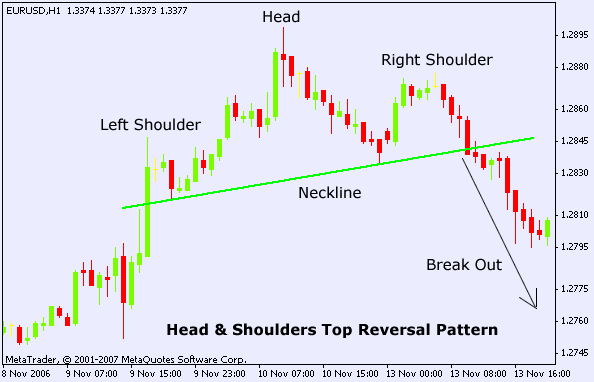| The Head and Shoulders Top marks a "reversal" pattern in an uptrend market and is extremely popular among currency traders. The pattern consists of 2 Shoulders, 1 Head and the Neckline (support): 1) The first point - the left shoulder - occurs as the price of the currency pair in a rising market hits a high and then fall back to the neckline. 2) The second point - the head - happens when prices rise to an even higher high and then fall back again to the neckline. 3) The third point - the right shoulder - occurs when prices rise again but don't hit the high of the head. 4) A key element of the pattern is the neckline and can be horizontal, slope up or slope down and is formed by drawing a line connecting two low price points of the formation. What does a Head & Shoulders Top reversal pattern look like?  The pattern is complete when support provided by the neckline is "broken." This occurs when the price of the currency pair, falling from the high point of the right shoulder, moves BELOW the neckline. Currency analysts will often say that the Head & Shoulders top pattern is not confirmed until the currency price closes below the support neckline - it is not enough for it to trade below the support neckline. Please note: The Head & Shoulders Top looks similar to a Head & Shoulders Bottom but reverse. How to trade this pattern?Go short when the currency price CLOSES below the neckline and put a stop-loss few pips above the last peak (right shoulder). Use a risk reward ratio 1.5 or better to calculate your profit target.(if you risk 50 pips, your target should be at least 75 pips). Chart example  EUR/USD 1 Hour Head & Shoulders Top reversal pattern Please note that the Head and Shoulders Top formation does not need to be perfectly symmetrical. |
Sunday, December 12, 2010
Forex Head & Shoulders Top Chart Pattern
Subscribe to:
Post Comments (Atom)
Hi there. Awesome post. Would you please clear my doubts on how the neckline points will be drawn accurately? Looking for more elaboration with some more examples.
ReplyDelete